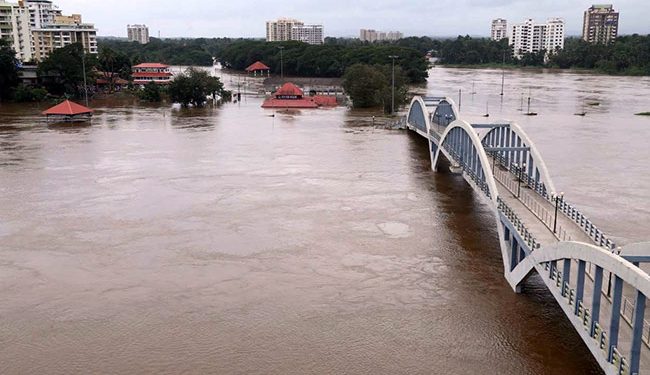God has forsaken His ‘own country’ – for a while at least. Non-stop rain and massive floods played havoc with life in Kerala for a week and more, leaving a trail of destruction and disaster. Over 300 lives have been lost, lakhs of people have lost their homes and hearths, and multitudes were herded into relief camps in five central-southern districts that bore the brunt. As the state raised all its resources to face the situation, some of the signals coming from the Narendra Modi government at the Centre were less than reassuring.
Life across Kerala – mostly urbanised with a city-state feel — remained disrupted for close to two weeks, the worst being the day of the deluge August 21. The World, many of the victims were convinced, was reaching its End. River levels in the region started rising and rising with alarming speed. The total loss is estimated at over Rs 21,000 crore, while the Union Government has come up with an aid of Rs 600 crore and more assistance has been promised. Notably, the estimated loss is of the order of over two-thirds of the state’s total Plan expenditure for the current fiscal – meaning, the administration is left with a gargantuan task of repairing the damage by way of re-construction efforts. Over a lakh children are in relief camps as of now.
Notably, the state’s population kept aside ideological and other differences and joined hands to provide succour to the suffering millions. Coordinated efforts by political parties, help by community outfits such as churches and mosques, and voluntary help from NGOs and individuals helped. Rescue operations taken up by fishermen with their country boats — they were omnipresent at flooded areas to extend a helping hand — were of immense help. They were among the saviours, the Good Samaritans, on the frontline of action and won wholesome praise for the timely support.
What has come as a major disappointment to the state, though, was the rejection by the Modi government of a reported promise of help for relief and reconstruction from the government of the UAE – where two million Indians or over 40 per cent of the tiny Gulf nation’s population, live and work. The offer of Rs 700 crore was reportedly conveyed by the UAE ruler first to NRI businessman Yousuf Ali, who relayed it to the state CM. There, however, is lack of clarity. The UAE ambassador in New Delhi has said what his country’s government did so far was to set up a panel to study the extent of losses suffered by Kerala and recommend suitable help.
When word spread about the UAE ‘offer’, the Union Government swiftly put a spoke in the wheel. The Centre ruled that government-to-government charity is not allowed and only institutional support could come in. It cited a guideline for receipt of foreign aid framed by the UPA government in 2004. Technicalities apart, the rough manner in which the Centre responded at a time when the state was in deep grief led to a massive electronic and social media outcry. This raised suspicion that politics guided the Modi government’s mind even at the time of such a huge disaster — in a state where the BJP has little public support. Irrespective of whether such an aid was promised or not, the Centre could have tempered its response in a more civil, sympathetic manner. Instead, an impression gained ground that the Centre was being rude and blocking a huge help from a friendly nation.
The Prime Minister’s brief aerial survey of the flood-hit areas, or his announcement of a Rs 500-crore relief, over and above an earlier offer from the Centre of Rs 100 crore, meant too little to the state.
This is not to ignore the material help that has come from the Centre for rescue and relief operations. The tone and tenor of the Centre, which spoke out through multiple channels, made all the difference. It had the shades of the Sangh Parivar rashness.
The reason for the flooding is a hotly debated topic.
Environmentalists blame the governments for non-implementation of the Gadgil formula on stemming the degradation of the Western Ghats; the saffron brigade sees God’s wrath over the large-scale killing of cows for meat in the state; and there are those who say Lord Ayyappa is angered over the flaws in observance of rites at the Sabarimala shrine. Blame is also on the Tamil Nadu government for release of excess floodwater from dams on the border; and, there are scientists who suspect a cloudburst added to the ongoing rainfall and the rise in water levels. When shutters of dams of over 30 rivers along the eastern high ranges were opened, the waters flowed to the western planes for final merger with the Arabian Sea. Along the way, it flooded habitations, submerged roads and bridges, and marooned villages and towns.
No one was spared of Nature’s fury. With power supply hit in several districts, fuel stations closed, roads flooded, net connectivity lost, phones failing to function and ATMs in dead mode, life stood still and almost everyone was hit. Through it all, impressively, everyone was out to help everyone. Relief efforts are on. Rehabilitation and reconstruction works will take time, possibly a year or more. The state government has warned against fund collections by individuals or institutions, other than direct contributions to the CM’s relief fund. This should hopefully minimise chances of fraud and misappropriation.







































